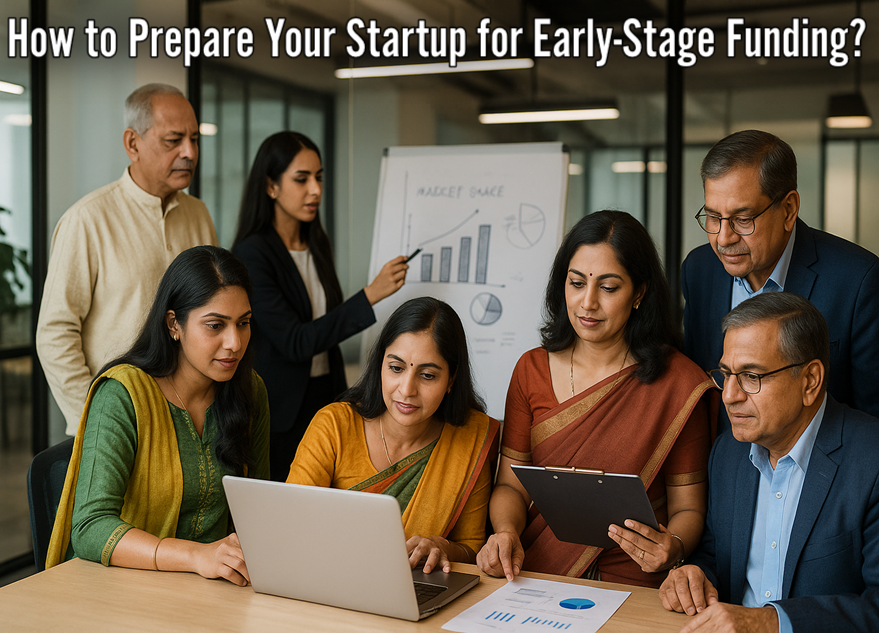Raising early-stage funding is a big milestone for any startup. It’s not just about money—it’s about building a foundation for long-term growth. Whether you’re targeting seed funding or venture capital, being well-prepared can make all the difference.
💡 Are you looking for Coworking space in Gurgaon, Noida or Delhi? We are just a call away. Call Now: 08999 828282
10 Best Ways to Prepare Your Startup for Early-Stage Funding
- Understand the Types of Startup Funding
- Build a Strong Business Plan
- Know Your Market and Competitors
- Create a Scalable Business Model
- Build a Prototype or MVP
- Prepare a Solid Startup Pitch Deck
- Get Your Financials in Order
- Build the Right Team
- Start Networking Early
- Choose the Right Investors
1. Understand the Types of Startup Funding
Before raising money, it’s essential to know the difference between seed funding, venture capital, and other funding types. Seed funding usually comes at the idea or prototype stage, often from angel investors. Venture capital typically comes later when there’s traction. Matching your startup’s stage to the right funding type helps you approach the right startup investors and avoid wasting time.

2. Build a Strong Business Plan
A solid business plan is a must-have for any early-stage startup. It should clearly explain what your business does, your market, revenue model, and how you plan to grow. This shows startup investors that you’ve done your homework. Be sure to include your vision, problem-solution fit, and a detailed funding strategy.
3. Know Your Market and Competitors
Investors want to know how well you understand your industry. Research your target market, customer segments, and competition. Highlight how your solution is different and better. Market knowledge strengthens your startup pitch and builds trust with potential venture capital firms.
Also Read: Why Startups Should Invest in Public Relations Right Now?
4. Create a Scalable Business Model
Investors fund startups that can grow fast and scale easily. Focus on designing a model where you can increase revenue without a similar increase in costs. Think about automation, outsourcing, and technology. A scalable business model is often a key factor in getting startup funding.
5. Build a Prototype or MVP
An MVP (Minimum Viable Product) helps show that your idea works. Even if it’s not perfect, a working prototype proves you can execute. It also gives investors something to see and test. MVPs are often critical to securing seed funding because they reduce the risk for investors.
6. Prepare a Solid Startup Pitch Deck
A well-structured startup pitch deck is your main selling tool. It should include key slides like problem, solution, market size, business model, traction, team, and financials. Keep it short (10-15 slides) and visually appealing. Practice your pitch often—it needs to be clear, confident, and convincing.
7. Get Your Financials in Order
Your numbers tell a story. Be clear about how much funding you need, how you’ll use it, and what outcomes you expect. Include revenue projections, expenses, and timelines. A detailed financial forecast builds investor confidence and supports your funding strategy.
8. Build the Right Team
Investors invest in people as much as ideas. A strong team with complementary skills increases your credibility. Highlight your team’s experience and how they’re suited to build and grow the business. The right team shows startup investors that your early-stage startup is in capable hands.
💡 Are you looking for Coworking space in Gurgaon, Noida or Delhi? We are just a call away. Call Now: 08999 828282
9. Start Networking Early
Don’t wait until you need funding to start building connections. Attend startup events, join accelerator programs, and engage with other founders and investors online. Relationships matter a lot in the world of venture capital. Being visible in the startup ecosystem opens doors to opportunities.
10. Choose the Right Investors
Not every investor is right for your startup. Look for investors who understand your industry and bring more than just money—mentorship, network, and advice matter too. Smart startup funding means finding partners who believe in your vision and can help you grow.
Getting early-stage funding is a critical milestone for any startup — and it starts with solid planning, a compelling pitch, and a clear growth strategy. Focus on building credibility, validating your idea, and showing real traction to investors.
FREQUENTLY ASKED QUESTIONS (FAQS):
Question: What is the difference between seed funding and venture capital?
Answer: Seed funding is usually the first official money raised to support your startup idea. It comes early in the business lifecycle. Venture capital comes later, when your business is growing and needs larger investments to scale.
Question: How do I find startup investors for my idea?
Answer: You can find startup investors through networking events, online platforms like AngelList, startup accelerators, and LinkedIn. A strong pitch deck and clear vision can help you stand out.
Question: Do I need a prototype before raising seed funding?
Answer: Having a prototype or MVP is very helpful. It proves your idea can work and gives investors confidence in your ability to build the product.
Question: What makes a great startup pitch deck?
Answer: A great pitch deck is short, clear, and visually appealing. It covers key areas like problem, solution, market size, business model, traction, and team. Practice your delivery to sound confident and natural.
Question: How much equity should I give up in early-stage funding?
Answer: It depends, but typically, startups give up 10–25% equity in seed funding rounds. It’s important to balance raising enough money while keeping enough control of your company.
Question: What financial documents do I need to show investors?
Answer: You’ll need a forecast of revenue and expenses, a cash flow statement, and a funding plan. Be realistic and ready to explain every number in your projections.
Question: How long does it take to raise early-stage funding?
Answer: It can take 3 to 6 months or longer. The process includes networking, pitching, due diligence, and legal paperwork. Start early and stay persistent.
Question: Can I get startup funding without revenue?
Answer: Yes, especially at the seed funding stage. Many early investors focus on your idea, team, and market potential. Revenue helps, but it’s not always required early on.
Question: What should I look for in a venture capital firm?
Answer: Look for firms with experience in your industry, a history of helping similar startups, and a network of useful contacts. Also, consider how involved they’ll be in guiding your growth.
Question: What’s the biggest mistake startups make when raising funding?
Answer: One big mistake is not being prepared—weak business models, unclear pitches, or not knowing your numbers. Always do your homework and be ready to answer tough questions.



